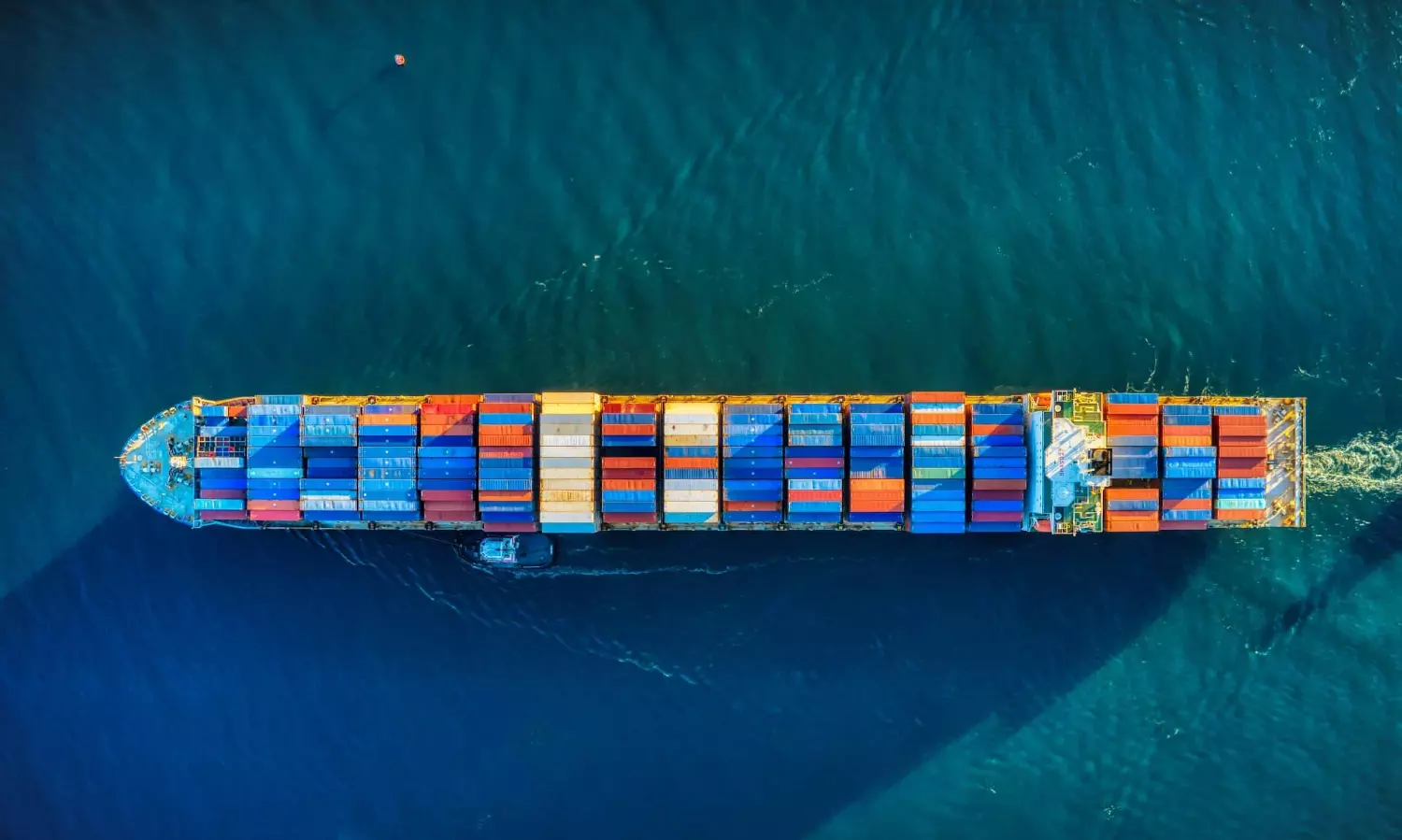Ocean freight rates will bounce back in 2024…with lots of challenges
Geopolitical wild cards (Taiwan, for example), environmental factors (Panama Canal, for example) and global pandemic (Covid, for example) are factors that cannot be ignored while planning for 2024.

With ocean freight rates hitting rock bottom, it seems shipping lines are subsidising shippers to move their cargo around the world, says Patrik Berglund, CEO, Xeneta while presenting the 2024 Outlook for Ocean Freight Shipping.
“What we can say is that the current rates are unsustainable. So, the question is when they will go up, not if they will go up," says Berglund. “From what we know, there’s little room to go further down. What’s most likely is they stay a little longer around this level, maybe go a little bit down, but they will, for sure, go back up.”
All the leading carriers - Maersk, Hapag and CMA-CGM - have reported huge declines in third quarter 2023 and nine months 2023 numbers - due to various factors including lower average freight rates.
Danish carrier Maersk reported a loss for its ocean business (negative $27 million) even as ocean revenue dropped 56 percent to $7.9 billion compared to $18 billion in Q32022, driven by significant pressure on rates in particular on Asia to Europe, North America and Latin America trades.
Maersk has reduced headcount from 110,000 in early 2023 to around 103,500, and, given the worsening price outlook in the ocean business, is intensifying measures and plans to further decrease the workforce by 3,500 positions. Nearly 2,500 positions will be reduced in the coming months, and the remaining to extend into 2024. This will reduce the global workforce to below 100,000 positions. Accordingly, the total expected restructuring charge is now expected at $350 million, up from $150 million announced in February.
German carrier Hapag-Lloyd reported a 77 percent decline in group profit at €3.2 billion for the first nine months of 2023 compared to €13.8 billion in the same period last year on 45 percent decline in average freight rate to $1,604/TEU.
Carried volume declined marginally to 8.92 million TEUs from 8.99 million TEUs in the corresponding period last year. Total revenue declined 47 percent to €14.1 billion from €26.7 billion in the first nine months of 2022.
While reiterating its forecast for 2023 of group EBITDA in the range of €4.1-5 billion (previously: €4-6 billion) and EBIT in the range of €2.2-3.1 billion (previously: €2-4 billion), Hapag says the forecast is subject to uncertainty given the many geopolitical conflicts, persistent inflationary pressures, and the continued high inventory levels of many customers.
French carrier CMA CGM reported an 82 percent decline in gross earnings from shipping to $1.6 billion in Q32023 from $8.6 billion in Q32022 on 52 percent decline in average revenue per TEU at $1,322. Volumes carried were up marginally (0.9 percent) at 5.9 million TEUs. Revenue was down 52 percent at $7.6 billion. Volumes continued to grow on the North-South and short-sea lines while further normalising on the East-West lines due to inventory drawdowns in the United States and more moderate household consumption in an inflationary environment, the carrier said while announcing Q3 results.
2023, 2024 and beyond
“New environmental regulations being introduced in 2024 are an additional complication for carriers in what is an already challenging market," adds Berglund. “These regulations will prohibit some carriers from utilising all of their capacity because their vessels are not environmentally-friendly enough and will go out of the market. As a result, we will continue to see slow-steaming and blank sailing.”
Container carriers are expected to report a loss of $15 billion in 2024, according to the latest Container Market Annual Review and Forecast from Drewry.
Simon Heaney, Senior Manager, Container Research, Drewry is expecting a 60 percent reduction in freight rates in 2023 "to be followed by a drop of 33 percent in 2024." The low freight rates, according to Heaney, are the outcome of the demand-supply mismatch - while supply is expected to increase 6.4 percent, demand growth is likely to be tepid at around two percent.
“Think about underlying weak macroeconomics - inflation rates, cost of living, interest rates and reduced global consumption," adds Berglund. "On top of that you have wider political turmoil and wars. There are still some heavy dark skies on the horizon and that could change the equation. But I still believe shipping lines will adjust to whatever demand is out there because anything else does not make sense.”
A view also expressed by Rodolphe Saadé, Chairman and Chief Executive Officer, CMA CGM Group: “The slowdown in the global economy is expected to continue weighing on our industry in the period ahead but volumes carried are still robust. We remain committed to controlling our operating costs, and are continuing to focus on decarbonising and digitising the supply chain to best meet our customers' needs.”
Vincent Clerc, CEO, Maersk also says: "Our industry is facing a new normal with subdued demand, prices back in line with historical levels and inflationary pressure on our cost base. Since the summer, we have seen overcapacity across most regions triggering price drops and no noticeable uptick in ship recycling or idling. Given the challenging times ahead, we accelerated several cost and cash containment measures to safeguard our financial performance. While continuously streamlining our organisation and operations, we remain dedicated to our strategy of fulfilling our customers’ diversified supply chain needs while pursuing growth opportunities across our Terminals business and Logistic & Services."
Hapag-Lloyd is working hard to reduce expenses, says CEO Rolf Habben Jansen "even more, such as by achieving savings on the procurement side and making adjustments to our service network. Nevertheless, if spot rates do not recover, we could face some challenging quarters in this subdued market environment."
Six key issues for 2024
Xeneta lists out six key issues for the container shipping industry for 2024:
Consumer spending
Capacity & fleet growth
Return of "classic seasonality"
Industrial action
Break-up of alliances
Carbon emissions
Consumer spending
High inflation may mean lower spending on non-essential goods. "2024 may herald the return of some level of seasonality to ocean shipping but underlying consumer demand will still hold sway over the market. Container shipping is inextricably linked to consumer spending, which in turn is directly impacted by global and regional financial outlooks. While inflation is easing in most western countries, it will still remain high in 2024."
Peter Sand, Chief Shipping Analyst, Xeneta says: “No two trades are alike - so you must understand the data across all the lanes in which you operate. If you track only the top trades you miss opportunities. For instance, while demand from China into North America and North Europe is down, Chinese products are finding new customers in the Middle East, ISC and South America with volumes growing quickly on those routes."
Capacity & fleet growth
As highlighted by Drewry, record levels of capacity will continue to cause a headache for carriers. Xeneta says: "As we look towards 2024, carriers will continue to do everything they can to reduce the overall cost of providing services to shippers. As the market will remain heavily stacked against them, they may look to measures that negatively impact their customers such as blanked sailings. To illustrate the point, throughout 2023 we have seen around 25 percent of announced capacity removed on Far East to North America trades."
Return of “classic seasonality”
The familiar ebb and flow of container shipping demand may return in 2024 - "but it won’t all be plane sailing... There is no doubt we are now transitioning out of the crazy Covid years and into something a little more recognisable. We expect these green shoots of recovery to flourish further in 2024, re-aligning the lost connection between importing containers and real underlying demand from consumers and businesses. This means carriers and shippers can expect the return of a semblance of “classic seasonality” during 2024."
Sand adds: “This will reintroduce normal volatility of spot rates. Shippers who have forgotten all about what that means will quickly remember if their timing of tendering collides with a classic spot rate lift which sees spot as well as long term rates go up. You need to stay on top of this because not all trades may react in the same way. When overcapacity reigns - as it will in 2024 - some trades may resist what we would traditionally consider normal.”
Industrial action
Industrial action on the U.S. East Coast could see shippers head back West but rates could be at a premium, says Xeneta.
“Any disruption due to industrial actions will impact cargo entering North America via U.S. Gulf Coast and East Coast ports from early in 2024," says Sand. "It could be painful as many shippers who changed supply chains during the unrest on the West Coast may find themselves with little other choice than to go back. Rates into the US West Coast will command a premium rate if this happens.
“That means the spread in pricing between East Coast and West Coast spot rates will fall below its parity of $1,000 per FEU. Shippers need to consider reliability and predictability of transit times and cargo movements, not just pricing.”
Break-up of alliances
MSC and Maersk got a jumpstart on this new reality when they decided to end the 2M alliance on January 25, 2023. The break-up of the 2M alliance, coupled with MSC’s aggressiveness in growing its fleet, is a wild card for 2024. "We will now also see how the other top carriers adjust to the new landscape."
Sand adds: “Shippers need to find out what strategy their logistics service supplier is adopting, as one may fully redeploy its fleet while another may concentrate on fewer services and less on global coverage. You can use this revealed position of your carriers to your advantage to get a better deal - in terms of both service and price.”
Sustainability in focus
Climate pressures on shipping are growing, and 2024 will see this increase with the introduction of the EU Emissions Trading Scheme (EU ETS).
"In principle, this scheme will see carriers applying another surcharge, which they hope will cover the cost of the allowances they need to buy for the carbon emitted on sailings within and to/from the EU. From a shipper perspective, these additional costs will be even more complex than bunker surcharges," says Xeneta in its report.
Based on legislation, carriers and freight forwarders will introduce "a plethora of new surcharges for shippers to negotiate," adds Sand. "These will muddy waters as we have seen in the range of surcharges already announced by carriers.”
Geopolitical wild cards (Taiwan, for example), environmental factors (Panama Canal, for example) and global pandemic (Covid, for example) are factors that cannot be ignored while planning for 2024.


